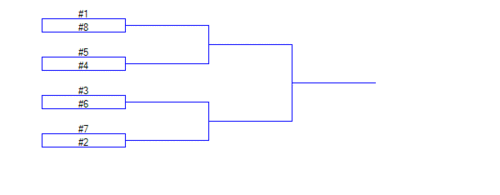Seeding: Difference between revisions
m (added info) |
MHStarCraft (talk | contribs) No edit summary |
||
| Line 2: | Line 2: | ||
{{competitive-stub}} | {{competitive-stub}} | ||
'''Seeding''' is the act of arranging players in a tournament bracket, usually to equalize both or all sides of the bracket in terms of skill, and so that the best players do not face each other until later rounds. Seeding is used so that players will usually receive placements proportianate to their skill levels. The name comes from the fact that a seed may either grow into the top-notch plant (i.e. the best player) or wither away (i.e. elimination). For example, in the first round of a perfectly seeded 8-player bracket, the best player, #1, competes with the worst player, #8. #2 competes with #7, #3 competes with #6, and #4 competes with #5. By seeding in this fashion, #1 and #2 will only face each other in the final round and will likely get 1st and 2nd place respectively, and lower-level players, having been eliminated by better players, will likely receive lower placements. [[File:Seededbracket.gif|thumb|500px|right|An example of a perfectly seeded bracket.]] If the bracket was not seeded properly, the best player, #1, could beat the second best player, #2, in the first round, and lower-level players would be able to advance farther due to weaker opponents being faced. In this situation, a weaker player could receive a higher placement than player #2. | '''Seeding''' is the act of arranging players in a tournament bracket, usually to equalize both or all sides of the bracket in terms of skill, and so that the best players do not face each other until later rounds. Seeding is used so that players will usually receive placements proportianate to their skill levels. The name comes from the fact that a seed may either grow into the top-notch plant (i.e. the best player) or wither away (i.e. elimination). For example, in the first round of a perfectly seeded 8-player bracket, the best player, #1, competes with the worst player, #8. #2 competes with #7, #3 competes with #6, and #4 competes with #5. By seeding in this fashion, #1 and #2 will only face each other in the final round and will likely get 1st and 2nd place respectively, and lower-level players, having been eliminated by better players, will likely receive lower placements. [[File:Seededbracket.gif|thumb|500px|right|An example of a perfectly seeded bracket.]] If the bracket was not seeded properly, the best player, #1, could beat the second best player, #2, in the first round, and lower-level players would be able to advance farther due to weaker opponents being faced. In this situation, a weaker player could receive a higher placement than player #2. | ||
[[Category: | [[Category:Competitive play]] | ||
Revision as of 10:31, May 10, 2014
Seeding is the act of arranging players in a tournament bracket, usually to equalize both or all sides of the bracket in terms of skill, and so that the best players do not face each other until later rounds. Seeding is used so that players will usually receive placements proportianate to their skill levels. The name comes from the fact that a seed may either grow into the top-notch plant (i.e. the best player) or wither away (i.e. elimination). For example, in the first round of a perfectly seeded 8-player bracket, the best player, #1, competes with the worst player, #8. #2 competes with #7, #3 competes with #6, and #4 competes with #5. By seeding in this fashion, #1 and #2 will only face each other in the final round and will likely get 1st and 2nd place respectively, and lower-level players, having been eliminated by better players, will likely receive lower placements.
If the bracket was not seeded properly, the best player, #1, could beat the second best player, #2, in the first round, and lower-level players would be able to advance farther due to weaker opponents being faced. In this situation, a weaker player could receive a higher placement than player #2.

